Posts Tagged: food
Apricot Jam 2009
The apricot canning project this year was small but reasonably successful. I lost very few apricots due to my branch supports, and we ate lots of fresh ones. Finally the day came when they had to be picked, and I brought them all in. I kept them in the fridge to try to have fresh fruit on hand for as long as possible. But last night the time came to preserve the rest.
I couldn’t find the online recipe I used last year that included orange zest. But I had lots of lemons and so just went with the easiest thing I could find that called for some lemon juice. It also called for about 3/4 cup sugar to each cup fruit. I ran out of regular sugar a cup shy and so substituted brown sugar for the last cup. I like the slightly darker flavor it adds, but in retrospect, I probably should have just cut the sugar by a cup anyway. This batch is a bit sweeter than I remember the batch from last year being.
But it’s fun just the same and I’ve got jam to get me through the fall anyway. I guess canning is catching on. I heard this NPR story the other day on how canning classes are in demand as people try to revive this ancient alchemical skill in order to beat the bad economy. I can’t help thinking that there are all these things we as a society are doing totally wrong because we have been bamboozled into thinking that we can’t do anything ourselves, and that real happiness comes from buying everything and making nothing. We only get a glimpse of the truth when pushed by a crisis to rethink what we’re doing. Well, more on this in a future rant. Right now, I’m going to eat some some toast and jam.
First of the 2009 harvest
We’ve had a few things from the garden so far this year, although it has been rather a disappointing one so far. A couple other people I talked to reported the same thing: things just didn’t seem to grow much through the spring. In my case, peppers, eggplant, basil and even some radishes, just didn’t really do anything. My guess is that we had too much fog this spring. (Never mind that today begins a little NorCal heatwave.)
Some other things, however, are doing fine. I have already dried about a quart and a half of Greek oregano. Many, many years ago my mom managed to bring back some oregano shoots from Greece and planted them at the house in Fresno. I had forgotten all about that, But when we were moving her up to the bay area, one of the things I noticed was a scraggly clump of oregano way in the back of the yard, past the grapevines. I was pretty sure this was the stuff from Greece, so I dug it up and planted it in my garden here. It is definitely different from the leafy stuff you get that the nurseries here. The leaves are very small, usually sparse, on long leggy stems. I understand that the Greeks don’t use the leaves much. They cut the stems when they are loaded with unopened flower buds and dry the buds. It is intensely aromatic. Maybe commercial oregano here is done the same way. I don’t really know.
The fruit trees are all happy this year, and of course the first crop to come in is the apricots. The tree got pretty loaded with fruit again this year, and again I couldn’t bring myself to thin it. But I was determined to avoid broken branches this year, so, I made some supports. It looks kinda greek hillbilly but it gets the job done. I think I’ll have enough for a few pints of jam.
Arriving in London
Sarah and i have arrived in London for the London Book Fair. Well, she’s arrived for that. I have arrived to accompany her while traveling and enjoy the city for three days. The flight was uneventful and as pleasant as nine hours in a confined space can possibly be. We are flying British Air. The food was fine, and we had decent red Bordeaux with dinner.
We rode the underground straight from Heathrow to Earl’s Court station, a stone’s throw from our hotel, the Barkston Gardens Hotel. After dropping off our bags and freshening up, we headed out for a stroll and then to a pub for dinner and ale. Photos and more details coming soon.
London is even more wonderful than I remember it. The first morning after arriving, I got up with Sarah, and we went down to continental breakfast in the hotel. From my perspective, the best thing about this breakfast is the toast. Soon after the server seats you, she brings you several triangles of toast, hot, unbuttered and standing on edge in a cute little rack. For a toast fiend such as myself this is quite a treat. Naturally, there is quite an assortment of condiments. The rest of the continental breakfast is fine but not particularly interesting.
Afterwards, I walked Sarah to Earl’s Court for the London Book Fair, and went on my way for the day’s exploration. I should mention right off that the weather here is just unbelievable right now, sunny and about 68 degrees, perfect for long walks in the city. I took the tube from Earl’s Court to Westminster. I walked out of the tube station and straight into view of Big Ben. I walked about taking some photos and started off in the direction of St James’s Park. But before I got far, something caught my eye. I will go into that, along with other details I’ve skipped, in the next post. Right now, I have to get back out into the city for day 2!
The Last Supper with More Than a Grain of Salt 2
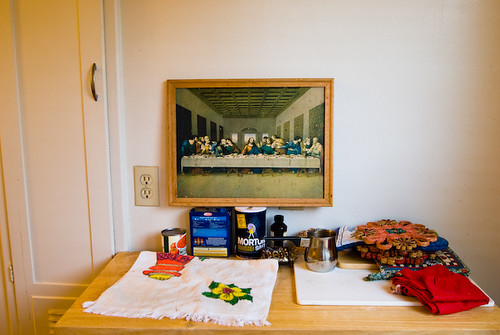
The Last Supper with More Than a Grain of Salt 2, originally uploaded by neocles.
This print of the last supper had always hung near the breakfast table in my parents’ home. It was no different here at my mother’s last apartment, although it had fallen off the wall and sat around for a few months. I set it back here the other day, and it seemed a fine place for photo. A detail shot would reveal drops of this and that, and a spattering of tomato sauce.
It is a bit of an odd assortment off things on the cupboard, most sitting for weeks without notice from mom. Tomato sauce, orzo, salt, vanilla flavoring, the Greek coffee pot (the briki), and assorted trivets. A couple times in recent months my mom had cooked food with some odd flavorings, like baked chicken with a heavy dose of cinnamon or ground cloves. Eventually she gave up on seasonings and then finally on cooking much of anything besides boiled eggs, green beans, or broccoli.
Today, we went to Kaiser for an eye check-up and to start the process of getting a new pair of glasses. She had misplaced her only pair. It turns out that her right eye needs just about the strongest lens available. The doctor could not determine a prescription for the left eye at all because she is nearly blind from a cataract. So, we’ll be going back for cataract removal, and then eventually for a prescription for the left eye. Shit, no wonder the apartment was a mess. And no wonder the chicken was seasoned with salt and clove instead of salt and pepper.
Russian Christmas Dinner
Russian Christmas Dinner
at Chez Serafimidis
Rocky Hill, Executive Chef
Our fun, Russian-themed menu for Christmas dinner this year.
First Courses
Chicken Pate, Neo
Dolmas, Neo
Smoked Salmon, Neo and Rocky
Pickled Herring, Rocky
Black Bread, Rocky
Soup Course
Christmas Borscht, recipe ideas, 1, 2, 3, 4, Ray and Marge
Main Course
Mushroom Pie, recipe idea, Ray and Marge
Red Beans with Herb Dressing, recipe idea, Carrie
Egg Noodle and Cottage Cheese Casserole, recipe idea, Kate
Goose stuffed with Apples, recipe ideas, 1, 2, Neo
Desserts
Apple Charlotte, Rocky
Sour Cream Cake, Rocky
apricot saga
About the apricot. In 2003 or so, I went down to Dwight Way Nursery and found this Blenheim apricot. It is supposed to be a dwarf or semi-dwarf, I can’t quite remember which.
I knew that there was some challenges to growing stone fruit around here. I know that they like a good cold winter to set fruit well, and, of course we don’t get much of that around here. A couple days of frost here and there is about it. Also, I know some people with peaches who report that periodically large chunks of the tree die for no apparent reason. Probably a blight that likes the relative dampness.
I chose apricot for a couple reasons. First, I thought that the smallness of the fruit might make it more likely that it will ripen. Secondly, my father planted an apricot at the house we moved to when I was five years old. That was a fabulous tree. It had a wonderful shape, an incredible crop almost every year, and the memory of it reminds me of my father. It lived for over 30 years until the renters i had in the house killed it and almost all the other fruit trees in the back yard through a couple fresno summers with no watering whatsoever.
In any case, my apricot produced no fruit the first season, about six or eight fruits the next couple seasons, and about a dozen last season. My friend Rocky had become fond of teasing me about the size of the cobbler he would be limited to in trying to do something with the “annual crop”. And last year, when the tree started the growing season with a perfectly balanced, bowl shape, and good new growth and budding, it suffered the mysterious die-back. One major branch on one side and a couple nearby small branches suddenly quit leafing, shriveled up, and died. The rest of the tree was basically okay, but it was misshapen and unbalanced. I put off my hopes to this year for both fruit and a return to form.
This year, there was not much weather during the spring. No hail, wind, or much rain came along to knock the beautiful blossoms from the tree. As the season progressed there was not a lot of new wood growth–not the several feet that previous years had seen. But it soon became obvious that there was a lot of fruit on the tree.
Around June 1st or so, my Neighbor Hugo said to me as we were admiring the tree, “you might get some 2x4s under a couple of those branches for support. You wouldn’t want them to break.” Well, I didn’t think this was much of a possibility. The aforementioned Fresno apricot never broke a branch no matter how laden with fruit. But after a couple of days, I took it more seriously, seeing that this young tree’s branches were still slender and there was a lot of fruit on them. What had been a narrow upright shape had now settled out into an open bowl of a branch structure. I propped them up with several bamboo sticks I had around.
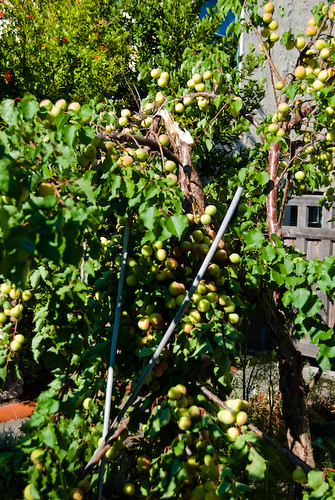
Then about a week later, we had a very windy night. I came out in the morning to find the largest branch of the tree broken, taking down about six feet of height from the tree and several pounds of not yet ripe fruit. I tried to salvage the fruit. Some, I picked and tried to ripen in a paper bag. Much of it I left on the broken branch in the hopes that what was left in the branch would continue to feed the fruit until it could ripen more. Each approach had success rate of about 2% of the fruit involved.
I was pretty disappointed, but there was still an incredible amount of fruit on the tree, so I got over it.
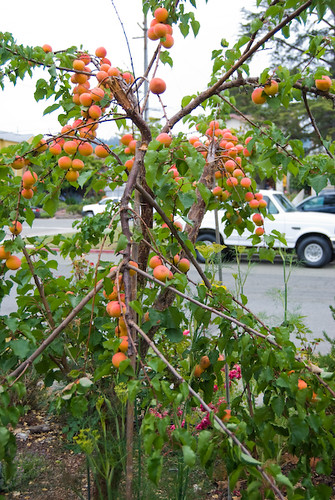
Then the other shoe dropped. About two weeks ago, not one, but two branches on the other side broke, despite being supported. There was a about 10 lbs. or more of fruit that had to be brought in. Fortunately, it was much closer to being ripe. I ripened much of it, and began eating it. As we did what was left on the tree, still a lot, was ripening and being brought in.
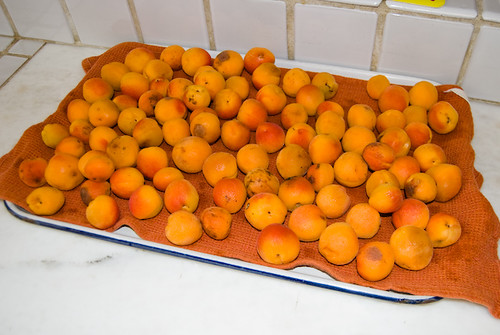
The past week we have been eating apricots like crazy. I gave some to Hugo next door. I gave some to my mom. We brought a bag to Fresno over the holiday. I made about four pints of preserves. I brought some to work. And still, we have a several pounds to pick and finish off the crop.

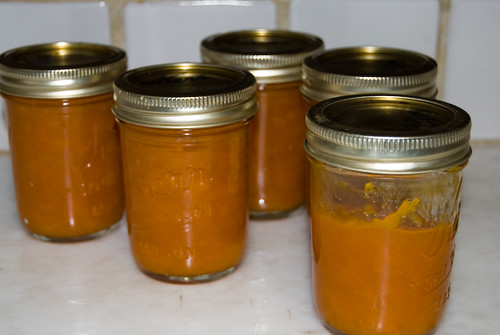
The lingering question is what the broken limbs mean for winter pruning, next spring growth, and the general shape and health of the tree. Only time will tell.
growing things
I live in Albany in the SF Bay Area. I like to garden, and I especially like to grow edible things. I am originally from Fresno, CA. Fresno is smack in the middle of the most productive agricultural region on the face of the planet. Collectively, these facts usually add up to some cognitive dissonance for me about this time of year.
In Fresno, you can grow practically anything and reap a bountiful harvest. In much of the Bay Area you can grow even more things, but the harvest part is much, much more challenging. This is often referred to as a “Mediterranean” climate, and to me, that brings to mind Greece. Note however, that Mark Twain did NOT say, “The coldest winter I ever spent was a summer in Athens”. The correct reference would be to San Francisco.
So while it is true that the climate in the Bay Area is mild and lots of things will grow, not everything fruits and ripens here. It just does not get hot enough for a sustained period for many fruit trees and vegetables like tomatoes and peppers to really produce a nice harvest. It gets frustrating because things do OK, but not great. Sometimes a plants, like tomatoes, just don’t look happy at all, no amount of feeding, watering, not watering, trimming, etc., cheers them up.
As with real estate so with gardening: location, location, location. I am still experimenting with varieties and locations. And admittedly, some things do just well. Lettuce comes to mind.
In the case of fruit trees, which no self-respecting Greek-American would omit from anything but the tiniest of gardens (for example pots on the apartment veranda), I began my efforts with a Blenheim apricot. But that is enough ranting for now; my experience with the apricot tree will be the subject of the next post.
Of carbs and men
This last weekend we travelled to the Marin coast to see my friend’s, Seth Dickerman, show at Bolinas Art Museum. I had a number of revelations.
I love his work even more than I thought I did. There is something genuinely mysterious and magical about the process that results in these deep, soft, obscure landscapes. I wonder if it can be achieved digitally. Seth both shoots film and is also a master printer, and so there is a physical process that occurs that produces special results. What I find particularly interesting is the simultaneous presence of both the blur and softness of hand-held long exposures, and some very sharp details that echo back into the depths of the image. There is also a way in which these images convey a tremendous sense of motion–not the motion of the photographers hands, but of a vast, wind-swept earth, sea and sky. I have experimented with my own handheld long exposures with the digital, but had only limited success. I am now more committed than ever to at it and someday learn to speak this wonderful language of unseen motion.
A more mundane but very important revelation I had was the this beautiful stretch of coast is so close to my home that there is no excuse for not visiting every other week. We stayed in Point Reyes Station, a mere 60 minutes from Berkeley. Somehow we forget how close it all is and how lucky we are to live in this part of the world. So, we are renewing our efforts to get out to Marin, Sonoma, and beyond at least a couple times a month.
Finally, a conversation I had over the weekend got me thinking again about how I regain the crispness of mind and energy that I used to have. That led me to two courses of action. The first is to get back to commuting by bike. I notice that really do have a better disposition and more energy when I do. The second more radical course of action is change my eating habits–in a way that will test my willpower like nothing has since I quite smoking many, many years ago. Basically it amounts to drastically slashing my consumption of high-carb food.
The problem is I LOVE bread. I mean I love it. I mean I could easily eat a loaf a day. In my Mediterranean culture, every meal is eaten with a fork in one hand and a piece of bread in the other. I eat several pieces of toast for breakfast every morning, with cheeses, yogurt, fruit, jams, eggs, whatever. How I am going to turn this around, I don’t know, but I have got to try.
I started today. Cheese, fake sausage patties, and fruit for breakfast. It was good and I somehow made until lunch time. For lunch I had, don’t laugh, a salad from Subway. It is one of the few places, and the only inexpensive one, to eat near my work in Emeryville. So, I have been going there on certain days for the six-inch special sandwich ($2.99) loaded up with veggies. So, today I had a turkey and cheese, hold the bread, extra veggies. It was actually pretty good and I made until dinner. At dinner I ate my first bread product of the day. I survived my first day with almost no bread!

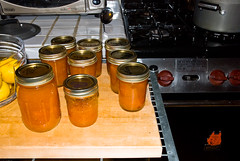

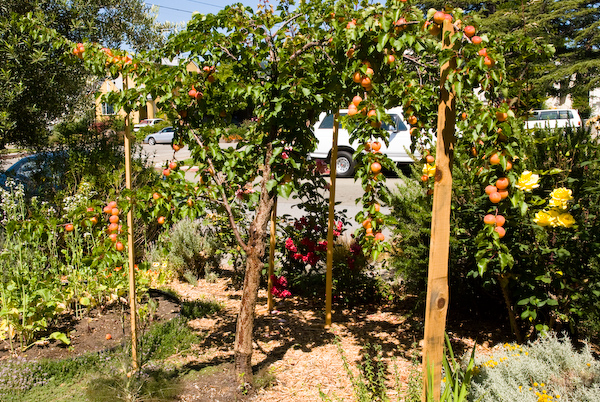

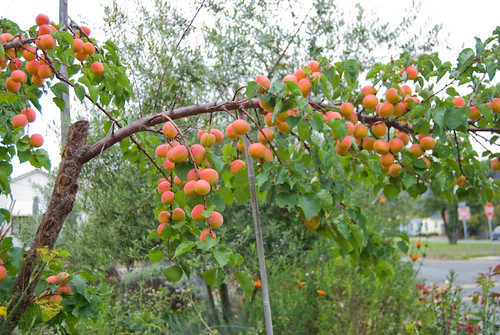


You must be logged in to post a comment.